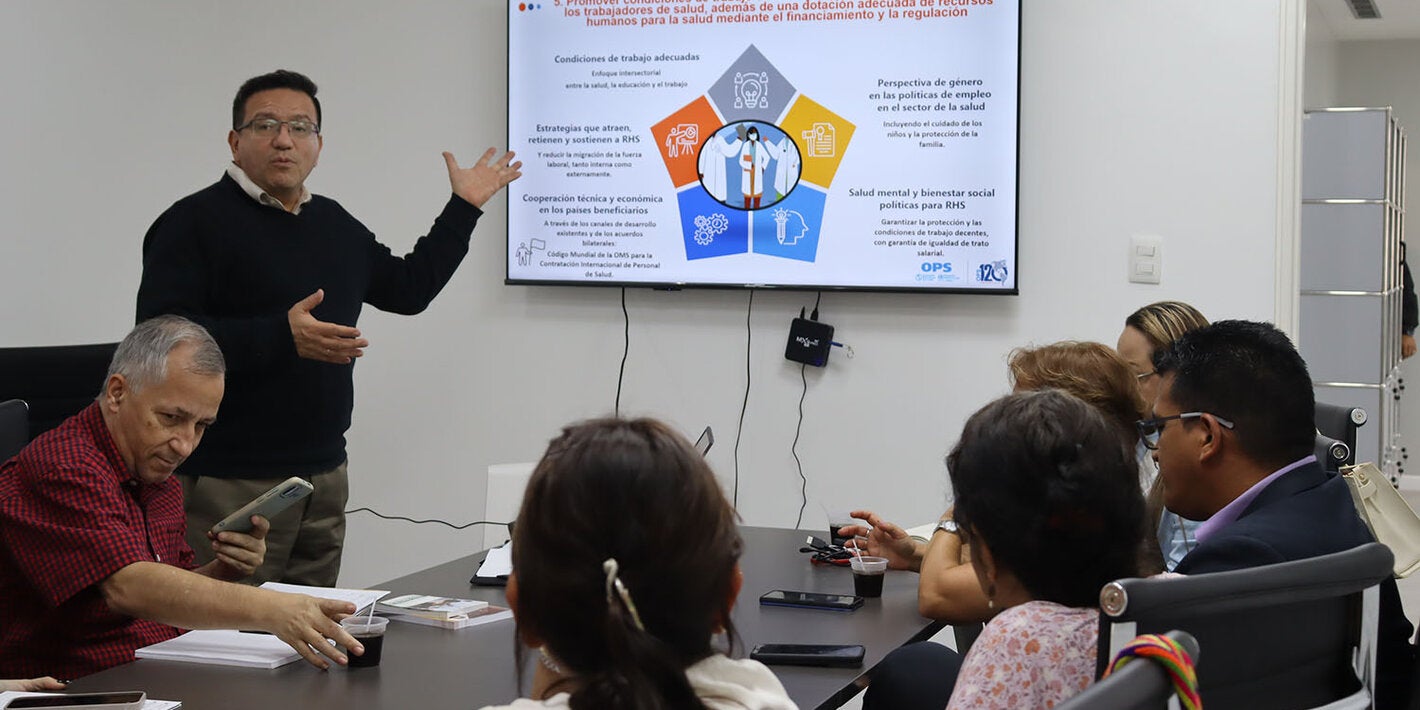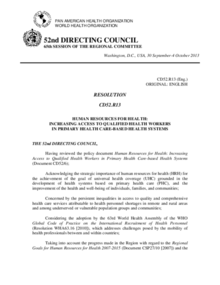Interprofessional teams consist of different professionals and health workers sharing a team identity and working together in an integrated and interdependent way to solve complex care problems and provide health services.
Evidence shows that interprofessional teams are essential to improve the health systems’ ability to meet the population’s health needs and to respond to health emergencies. Interprofessional collaboration improve health outcomes by decreasing morbidity and mortality rates; increase patient satisfaction; contribute to health care workers retention by reducing extra work and increasing job satisfaction; and reduce medical errors and preventable complications.
It is important to note that in real settings, health teams consist not only of professionals but also technicians and community workers, and this is especially true for interprofessional teams at the first level of care.
Several PAHO/WHO Resolutions and other technical documents state the need for organizing interprofessional teams to improve the health systems’ ability to meet the population’s health needs and to respond to health emergencies. The document CD/60.6 “Policy on the Health Workforce 2030: Strengthening Human Resources for Health to Achieve Resilient Health Systems”, approved by PAHO’s Member States in 2023, proposes five lines of action, the third being strengthening the organization of interprofessional teams and their incorporation into integrated health services networks based on primary health care. It calls for organizing interprofessional teams at the first level of care, with response capacity, the right skills, and an intercultural and social determinants approach to health to deal with the specific circumstances of populations in conditions of vulnerability.
In this context, the purpose of PAHO’s technical cooperation is to support the development and implementation of national and local planning processes and strategies to organize, strengthen, and incorporate interprofessional teams into integrated health services delivery networks at all levels of care in the context of PHC, with emphasis on the first level of care.
- Many health systems throughout the world are segmented, fragmented and struggling to manage unmet health needs.
- Present and future health workforce are tasked with providing health-services in the face of increasingly complex health issues.
- Evidence shows that opportunities gained through interprofessional experience help health professionals learn skills needed to become part of the collaborative practice-ready health workforce.
- The provision of care through interprofessional teams is based on extensive evidence. After almost 50 years of research and practice, evidence shows that collaborative practice has clear benefits for patients, practitioners and for the health system as well.
- In both acute and primary care settings, patients report higher levels of satisfaction, better acceptance of care and improved health outcomes following treatment by a collaborative team.
PAHO/WHO has developed a conceptual framework with core elements to be considered by policy makers and health managers into start the organization or strengthening of interprofessional teams, as well as practical aspects to support the integration of interprofessional teams into health service delivery networks in real settings at the local level. The core elements include the following:
- Interprofessional teams work best under a clear, previously defined collaborative, person-centered model of care.
- Interprofessional teams should be trained and organized with a public health lens, based on the Essential Public Health Functions.
- Interprofessional teams should be trained and organized to implement action plans that are comprehensive, age, stage-of-life and disability-sensitive, and gender-responsive, with a focus on human rights.
- Interprofessional teamwork must be founded upon six key principles: clear goals (the primary goal being effective care); shared team identity; shared commitment; clear team roles and responsibilities; interdependence between team members; integration between work practices.
- To ensure a good relationship among the interprofessional team members, four key factors should be fostered: mutual respect of each other’s role and expertise; collaborative action for working and learning together; deep understanding of each other’s strengths and limitations; common goals and values.
- To carry out interprofessional practice, six core competencies must be developed and incorporated under the interprofessional learning domains: teamwork; roles and responsibilities; communication; learning and critical reflection; relationship with and recognizing the needs of the patients, the users of the services and the community; ethical practice.
Our priorities
Eight main elements are proposed as operational entry points for technical cooperation to assist the countries in the process of starting or strengthening the organization of interprofessional teams, consisting of actions to be carried out at regional, subregional and country level:
- Promote and advocate for the organization of interprofessional teams through dialogue with policy makers, health and education authorities, and other relevant partners.
- Support the development and implementation of policies, plans, strategies, regulations, and standards to increase the availability of HRH in underserved areas through interprofessional teamwork.
- Assist the countries in the identification of profiles and competencies of health personnel at the first level of care and identify gaps that may be closed by interprofessional teamwork.
- Develop guidelines and recommendations to organize, insert and strengthen interprofessional teams and to expand their roles according to local needs.
- Promote changes in the curricula for graduate and post-graduate education to strengthen collaborative practice in health services from the beginning of the educational training.
- Support life-learning training strategies to increase interprofessional teams’ capacities to carry out interprofessional practice.
- Assist health managers’ planning process to insert interprofessional teams at the first level of care.
- Promote the establishment of monitoring and evaluation mechanisms of interprofessional teamwork and disseminate evidence and lessons learned related to processes, outcomes and impact of interprofessional teamwork.






